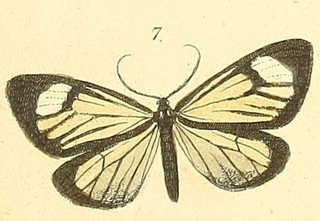
Ephialtias bryce is a moth of the family Notodontidae. It is endemic to the basin of the Rio Tapajos in Brazil.
Sagittala is a genus of moths of the family Notodontidae. It consists of only one species, Sagittala peba, which is found in Panama and Costa Rica.
Eremonidia is a monotypic moth genus of the family Notodontidae. Its only species, Eremonidia mirifica, is known from two mountain ranges in the south-western part of the Dominican Republic. Both the genus and species were first described by John E. Rawlins and James S. Miller in 2008.
Erbessa basivitta is a moth of the family Notodontidae first described by Louis Beethoven Prout in 1918. It is found in Brazil.
Erbessa conigera is a moth of the family Notodontidae first described by Louis Beethoven Prout in 1918. It is found in Peru and Ecuador.
Erbessa continens is a moth of the family Notodontidae first described by Louis Beethoven Prout in 1918. It is found in Ecuador, Peru, Bolivia and Brazil.
Erbessa cuneiplaga is a moth of the family Notodontidae first described by Louis Beethoven Prout in 1918. It is found in Suriname, French Guiana and Brazil.
Erbessa integra is a moth of the family Notodontidae first described by Cajetan and Rudolf Felder in 1874. It is found in Brazil.
Erbessa labana is a moth of the family Notodontidae first described by Herbert Druce in 1895. It is found in Venezuela, Ecuador, Peru and Brazil.
Erbessa leechi is a moth of the family Notodontidae first described by Louis Beethoven Prout in 1918. It is found in Brazil and French Guiana.
Erbessa seducta is a moth of the family Notodontidae first described by Louis Beethoven Prout in 1918. It is found in Venezuela.
Xenorma australis is a moth of the family Notodontidae. It is found in Brazil.
Argentala subcaesia is a moth of the family Notodontidae first described by Louis Beethoven Prout in 1918. It is found in Colombia.
Polypoetes empheres is a moth of the family Notodontidae. It is found in south-eastern Peru.
Polypoetes villiodes is a moth of the family Notodontidae. It is found in Colombia.
Brachyglene patinata is a moth of the family Notodontidae first described by Louis Beethoven Prout in 1918. It is found in Brazil.
Nebulosa latialbata is a moth of the family Notodontidae first described by Louis Beethoven Prout in 1918. It is found in eastern Ecuador.

Monocreagra pheloides is a moth of the family Notodontidae first described by Cajetan and Rudolf Felder in 1874. It is found in Colombia, Ecuador and Peru.
Dolophrosyne mirax is a moth of the family Notodontidae first described by Louis Beethoven Prout in 1918. It is found in Peru and Bolivia.
Euchontha anomala is a moth of the family Notodontidae first described by Louis Beethoven Prout in 1918. It is found in Brazil and Peru.

